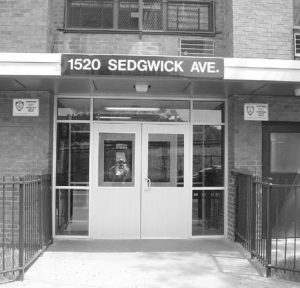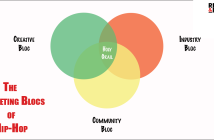1520 Sedgwick Avenue, Bronx, New York City, is the birthplace of Hip-Hop. At this address, on August 11th, 1973, Kool Herc, an African-American DJ, threw the first hip-hop party.
Today, hip-hop is a culture with a global reach and influence. It has four core elements; DJing, Rapping, Breakdancers (Beat Boys)/Beatboxing, and Graffiti. Other elements are knowledge (philosophical or intellectual), fashion, beat-making, and language.

Rap or hip-hop music has influenced a lot of minority and oppressed groups over the years. It has become a tool for these people to tell their stories or tune away their worries with dance songs, the original themes for hip-hop in the 70s.
Contrary to popular opinion, hip-hop messages could cut deep or simply “here for a good time and not for a long while” type of message. It can also be traditional; lyricism, no harmonising, and melody in the delivery of verses. Or progressive; create a new sub-genre in hip-hop as the unique sound, e.g. Trap, Mumble rapping, etc. At one point in hip-hop timelines, some of what constitute traditional sounds were that era’s progressive sounds.
Emcees should be allowed to express themselves in any sound and tone they want. Hip-hop music started by taking breakbeats from already existing genres; jazz, blues, soul etc., arranging them, looping them, and extending them. It is only natural to assume that hip-hop beats are sampled from popular songs, past or present, enjoyed by the elite (snubs) and mature demographic.
The art of sampling has made it easy for communities (outside the African-Americans and Latinos) in other countries to absolve hip-hop into their culture. Yes, music to pay homage to US hip-hop practitioners, as per the movement’s founders, is made. Then comes the unique part. Every culture produces its hip-hop and tries to share it with the world as much as possible by collaborating with foreigners. An exchange of culture in 4mins or less with possible lifetime effects felt.
Fun Fact: The modern Afropop (Afrobeats) genre is heavily influenced by the Hip-hop lifestyle – music videos, rhyming in songs, use of street slang, and fashion.
RAPPING
Rapping is a musical form of vocal delivery incorporating rhyme, rhythmic speech, and street vernacular. It can be performed with or without a backing beat or musical accompaniment. Rapping is made up of 3 components; content (what is being said or talked about), flow (rhyme and rhythm), and delivery (cadence, tone, enunciation, etc.). In delivery, some rappers use figures of speech (MF Doom uses similes upon similes), while Nas, JayZ, and 2Pac are usually more direct in delivery.
Rapping is a hip-hop subculture – hip-hop/rap music, battles, freestyle (scripted and freestyling). Scripted freestyle rap is more like recitation. This is the “make I freestyle on this beat real quick” freestyle with no subject matter, and the rapper is spitting rhymes they’ve written before. On the other hand, Freestyling or Spitting is one with a subject matter, or words to rhyme with are given, or simply taking cues from the surroundings to rhyme with. This latter form of freestyle gave birth to rap battles. Rap music was the last sub-culture to be developed and is currently the biggest in the hip-hop industry.
BEAT-MAKING
Beat-making as a subculture developed over the years as rap music became the tool for spreading the Hip-hop culture across the globe. Unlike the ’70s hip-hop parties, producers now create beats using plugins, instruments, or simply taking pieces of different existing rhythms and editing them (chopped, pitch, and direction of play) to make an entire sequence or beat for rap music or soundtrack.
Hip-hop beats were made originally from the drums in breakbeats played at the Kool Herc parties. No percussions, no strings. As it entered the White alternative music space of the 80s, Punk Rock, DJs started sampling other parts of beats with other musical instruments. This was the beginning of the fusion of other genre sounds with hip-hop.
Rick Rubin of Def Jam was the first to produce a record that didn’t use the usual sampling method of turntables to create the beats they wanted. He called Tim Collins, manager of The Aerosmiths, to have them recreate the sequence of the rhythm they wished to use for the remake of their single, Walk This Way, for Run-DMC. The first cross-over rap feature song was produced.
Rap beats have since continued to push boundaries over the years.
KNOWLEDGE
The philosophical/intellectual subculture of hip-hop was introduced via lyrical content, but it wasn’t usually like this. Back in the ’70s, the era of the parties, everyone would attend; drug dealers, armed robbers, killers, gangs, pimps, etc., led to a room for dialogues.
The first person to explore this avenue was Afrika Bambata, a DJ. He was a member of the biggest street gang back then, Black Spades. He used his parties to unify the gangs and hold forums with street gang leaders for a dialogue to squash the beefs and end violence in the community.
The movement later became the Zulu Nation, an organisation of different street gangs that slowly became gentrified by expressing themselves with hip-hop; DJing, rapping, graffiti, beatboxing and breakdancing. The first movement against violence was created.
Over the years, the content of rap music has been used to pass information, strengthen the oppressed, and motivate those giving up on how to better themselves and their lives.
The typical emcee is from the hood, so he has experienced or gone through everything someone somewhere is currently experiencing. They are just reassuring you or giving you new information on how to overcome your life challenges. This has fostered a reading culture amongst Blacks in general.
People now question conventional thoughts, their oppressors on why they feel oppression is the weapon they must resort to. Why not collaborate to grow rather than keep us timid and oppressed?
This is the real hip-hop movement—the right to expand your thinking.
I have a working theory that might come with a bit of backlash. If we, as Nigerians, paid more attention to our hip-hop genre rather than gish-gish music and content, the #EndSars movement would still be strong. Like it or not, we lost the fight. Now we know it’s a marathon, and it is hard.
BLM has been going on forever, but first, they are taking time to educate everyone affected by institutionalised racism on how to stay alive and prosper in modern America by dropping the street rat mentality and investing in themselves and one another.
Over here, our conversations are banter, bet code, “I said what I said”, and ridiculing each other’s financial situations.
Wunderbar!
Rappers and Artistes are giving back to their communities. No matter your growing conditions, someone out there has it worse than you, and you can do something to help provide a little bit of leverage for members of your community.
It could be a recreational facility where local sports enthusiasts and kids can hone their skills and enter professional sports. A vocational centre for the geeks and artisans to acquire and hone both soft and hard skills.
The more people able to leave the ghetto, the more those that invest back into the livelihood of those still living there.
I digress. This is a hip-hop article, not a political one. Before I move on, I suggest we figure out how to spread humanity and a new “help the next man” mentality across every or majority of Nigerians. The best tool for this is music.
As stated earlier, the ability to customise hip-hop to suit your local language, culture and community is one of the primary reasons it has expanded globally. You can create your hip-hop based on the local sounds and instruments in your communities; it could be the speech pattern of your native tongue or other forms of delivery that aren’t conventional.
Some rappers stuck to their styles and created an entire sub-genre of hip-hop for a whole State or City. Pimp C and Bun B of trunk music (beat), E-40‘s flows, Bone Thugz with their fast melodic delivery etc.
You also should note that because it is customisable, it doesn’t mean your joint or style will always be dope. It could be alright, or it could be straight-up wack. Consider the opinions of your immediate listeners, friends, producers, and family members when deciding on sticking to or changing a sound or style. They are mostly never wrong.
Thus, you don’t need to make music or sound like the most commercially successful artist to become a success. It works, but it is short-lived unless you plan to take that artiste’s style to the next level. Just ensure that the four components of rapping are in your style and it can be stretched; content (good time or conscious), tempo (fast or slow), and pitch (high or low) wise. You just might smile bigly to the bank.
CLOSING
Welcome to Rhyme & Reason. A hip-hop magazine focusing on accuracy rather than the speed of breaking news. Interviews with hip-hop culture practitioners, reviews, news, and information on all hip-hop subcultures will be provided on R&R®.
If it is on R&R®, it either happened, is happening, or will happen. The information is verified. We will play our role in growing and improving the hip-hop culture in Nigeria and Africa, nothing more, nothing less.
We are creating a bank of information about the culture, the art, and the artists for future generations to develop a timeline of hip-hop history in Nigeria and Africa. This will also acknowledge the hard-work artists and other hip-hop practitioners put in to hone their craft and appreciate their growth. We will look at their motivation despite the bleakness of their situations and circumstances.
The progressives today define tomorrow’s traditions. So, whether it is “have a good time” content or “take your life more seriously” music, we want to curate all of these ideologies objectively and look at how they shape the generations that come up with them or practice them.
Not bad for a movement that began from an apartment in the ghettos of the Bronx.
We are here for a long time and in good and bad times.
I remain your favourite Local Man.




